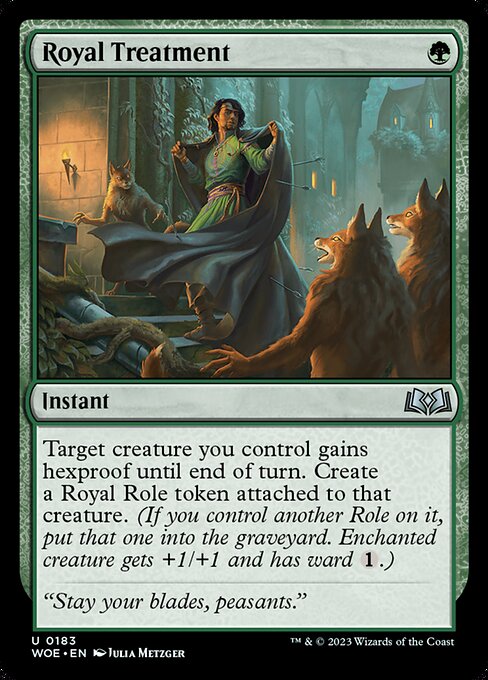
Top Performing Decklists
| Deck | Creator | Record | Best Finish |
|---|
Performance Stats (Last 14 Days)
Win Rate Impact
Top Table Win Rate
Meta Trend
Sample Size
Tournament Results
Average Copies
Archetypes Using This Card:
Bant Auras , Golgari Deathtouch , Golgari Demons , Golgari Midrange , Gruul Aggro , Gruul Delirium , Gruul Dinosaurs , Mono Green Ramp , Naya Auras , Selesnya Artifacts
Meta Performance Analysis
Royal Treatment ranks #24 out of approximately 406 cards in raw efficiency (top 6%).
Game Impact Factor
Color Differential
Green average: 65.6%
Performance compared to other Green cardsBased on our comprehensive multi-metric analysis, Royal Treatment is a very strong card that performs well in most contexts.
Recommended number of copies: 4
Win Rate Timeline
Card Efficiency Analysis
Raw Efficiency (Win Rate/Mana)
Relative Efficiency
Performance Efficiency: 80.00 (Win rate × Top 8 rate ÷ Mana value)
At 1 mana, the average win rate in the format is 76.0%. Royal Treatment has a win rate of 80.0%, making it 5.3% better than other 1-mana cards.
Top Performing Partners
| Card Name | Type | Deck Count | Win Rate | 1st Places |
|---|---|---|---|---|
| Blot Out | Instant | 9 | 82.9% | 3 |
| Tough Cookie | Artifact Creature — Food Golem | 9 | 82.1% | 5 |
| Novice Inspector | Creature — Human Detective | 9 | 82.1% | 5 |
| Warden of the Inner Sky | Creature — Human Soldier | 9 | 82.1% | 5 |
| Teething Wurmlet | Creature — Wurm | 9 | 82.1% | 5 |
| Steel Seraph | Artifact Creature — Angel | 9 | 82.1% | 5 |
| Regal Bunnicorn | Creature — Rabbit Unicorn | 9 | 82.1% | 5 |
| Dusk Rose Reliquary | Artifact | 10 | 79.9% | 5 |
| Kellan, Daring Traveler | Legendary Creature — Human Faerie Scout // Sorcery — Adventure | 9 | 76.6% | 5 |
| Unidentified Hovership | Artifact — Vehicle | 10 | 76.4% | 5 |
Card Synergy Analysis
Cards that perform better with Royal Treatment than they do on average. A positive synergy score indicates stronger performance together.
| Card Name | Type | Mana | Decks | Win Rate Together | Win Rate Apart | Synergy Score |
|---|
Top Archetypes
| Archetype | Deck Count | % of Archetype | Win Rate |
|---|---|---|---|
| Golgari Demons | 24 | 4.4% | 61.1% |
| Gruul Aggro | 18 | 0.9% | 37.1% |
| Golgari Midrange | 10 | 1.3% | 79.6% |
| Selesnya Auras | 9 | 81.8% | 39.5% |
| Selesnya Artifacts | 9 | 42.9% | 82.6% |
Statistics Explanation
| Statistic | Description | Formula |
|---|---|---|
| Win Rate Impact | How much this card increases or decreases the win rate of decks that include it, compared to the average deck in the format. | (Win rate of decks with this card) - (Average win rate of all decks) |
| Top Table Win Rate | A weighted win rate that gives more significance to performance in higher tournament placements. First place finishes count for 2x, with diminishing weight down to 8th place. | ∑(wins × placement_weight) / ∑((wins + losses) × placement_weight) |
| Meta Trend | Shows if the card is performing better or worse in the most recent period compared to earlier periods. Positive values indicate improving performance. | (Win rate in recent half of time period) - (Win rate in earlier half of time period) |
| Confidence Factor | A measure of statistical reliability based on sample size. The progress bar indicates how confident we are in the statistics (with larger sample sizes providing higher confidence). | log10(Number of decks + 1) |
| Average Copies | The average number of copies of this card included in decks that use it. | ∑(Copies in each deck) / (Number of decks) |
| Card Synergy Score | Measures how well this card performs with other cards compared to their individual performance. | (Win rate together) - (Average of individual win rates) |
| Raw Efficiency | Win rate points per mana invested. Higher values indicate better returns on mana investment. | (Win rate) / (Mana value) |
| Relative Efficiency | How efficient this card is compared to the average card of the same mana value. | ((Win rate) / (Format average win rate for same mana)) / (Mana value) |
| Performance Efficiency | Combined metric that accounts for win rate, tournament success, and mana investment. | (Win rate × Top 8 placement rate) / (Mana value) |
| Game Impact Factor | A measure of how much this card affects game outcomes, based on win rate adjusted by its deviation from the format average. | Win rate × (1 + (Win rate - Format average) / 100) |
| Color Differential | How this card's win rate compares to the average win rate of other cards of the same color. | Win rate - Average win rate for same color |
All statistics are calculated using tournament data from the selected time period. Sample sizes below 10 decks may not provide statistically significant results.